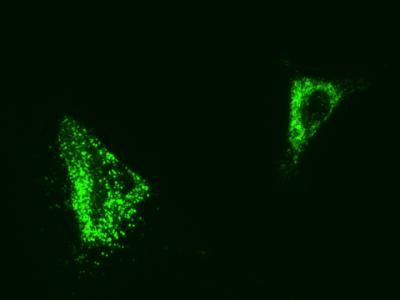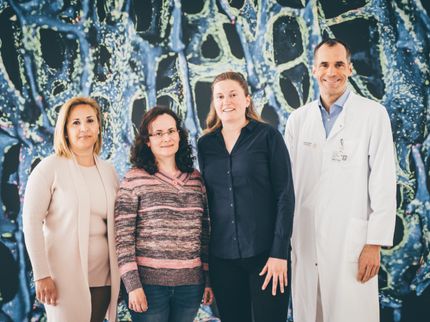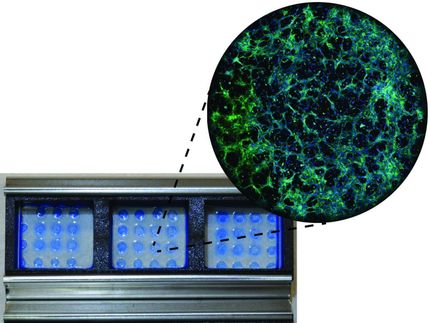Biomaterials get stem cells to commit to a bony future
Researchers discover exactly how calcium phosphate can coax stem cells to become bone-building cells
With the help of biomimetic matrices, a research team led by bioengineers at the University of California, San Diego has discovered exactly how calcium phosphate can coax stem cells to become bone-building cells. This work is published in the Proceedings of the National Academy of Sciences.

Image of three human mesenchymal stem cells. The ATP in the cells is glowing green. The phosphate from the biomaterial (calcium phosphate) that is taken up by the cells is used to make more ATP, which is traditionally the source of energy for the cells. In this case, however, ATP can be converted to adenosine which promotes the human mesenchymal stem cells to be turned into bone cells. This image illustrates some of the work pursued by an international team of researchers led by bioengineers at the University of California, San Diego. The researchers discovered exactly how calcium phosphate can coax stem cells to become bone-building cells.
UC San Diego Department of Bioengineering
UC San Diego Jacobs School of Engineering professor Shyni Varghese and colleagues have traced a surprising pathway from these biomaterials to bone formation. Their findings will help them refine the design of biomaterials that encourage stem cells to give rise to new bone. The researchers say their study may also point out new targets for treating bone defects and bone metabolic disorders such as major fractures and osteoporosis.
The materials are built to mimic the body's own cellular niches, in which undifferentiated or "blank-slate" stem cells from bone marrow transform into specific bone-forming cells. "We knew for years that calcium phosphate-based materials promote osteogenic differentiation of stem cells, but none of us knew why," Varghese said.
"As engineers, we want to build something that is reproducible and consistent," she explained, "so we need to know how building factors contribute to this end."
The researchers found that when phosphate ions gradually dissolve from these materials, they are taken up by the stem cells and used for the production of ATP, a key metabolic molecule. An ATP metabolic product called adenosine then signals the stem cells to commit to becoming bone-forming cells.
Varghese said it was a surprise to her team that "the biomaterials were connected to metabolic pathways. And we didn't know how these metabolic pathways could influence stem cells' commitment to bone formation."
While the PNAS findings only apply to bone building, Varghese and her students at UC San Diego are working on a variety of projects to understand how stem cells thrive and differentiate into a variety of cell types. With this information, they hope to design biomaterials that can be used to help transform stem cells into tissues that may someday replace diseased or degenerated bone, muscle, or blood vessels.
Stem cell research may seem like an unusual endeavor for engineers, but tissue construction and the development of biomaterials have become one more type of "building" in the engineering repertoire, Varghese said.
"But to me, what we do is use engineering principles to solve a biological problem, and by integrating many research disciplines from molecular biology to engineering to medicine," she added.
"This research is a testimony to how international collaborations could provide unique opportunities to young researchers to tackle interdisciplinary questions relevant to medical sciences," Varghese said.

























































